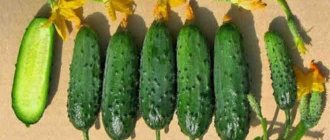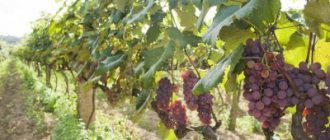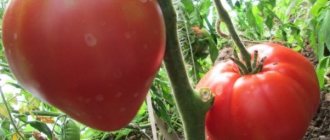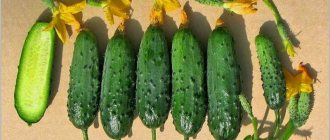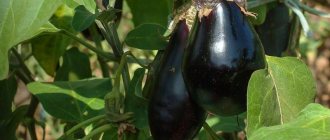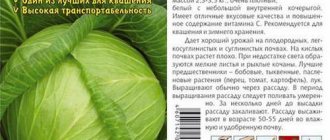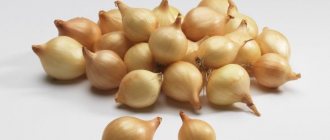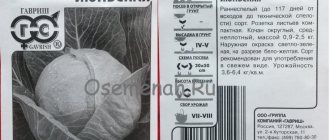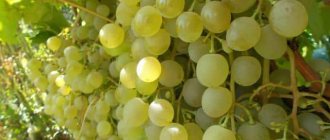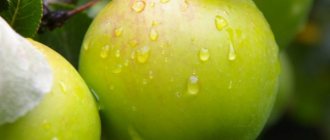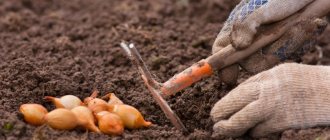» Vegetable growing » Cucumbers » Growing cucumber Kibria
0
1234
Article rating
Among all varieties, the Kibria cucumber is in particular demand. It was bred quite recently, in 2009, by Dutch breeders, but after 2 years it was included in the state register. The main purpose of the variety is cultivation during the winter-spring and spring-summer seasons.
- Advantages and disadvantages of the variety
- Growing seedlings
- Planting scheme
- Necessary care
- Transplanting seedlings into the ground
- Care
- Watering
- Weeding and loosening the soil
- Feeding
- Bush formation
- Harvesting
- Reviews from gardeners
Growing cucumber Kibria
Description of the cucumber variety Kibria
Kibria comes from Holland, where it was obtained by dihybrid crossing in 2009. This variety was bred for year-round fruiting in greenhouse conditions.
Due to the high yield rates and absolute safety of the product, it was allowed for planting in Russia. In 2011, the hybrid was included in the State Register of the Russian Federation. It is recommended for cultivation in the Central and Northwestern regions of the country.
High rates of fruiting of Kibria cucumbers are possible on soils rich in nutrients. Since the plant is self-pollinating (parthenocarpic), it is more appropriate to grow it in greenhouse beds. But, as practice shows, cucumbers grow well in open areas, without a greenhouse cover.
Cucumbers of the Kibria variety are a liana-shaped plant, where the main stem is fruit-bearing. Side shoots do not grow. The bush itself is large but compact. Growing rapidly, the main stem is not limited to a flower cluster. Because of this, the plant must be tied to a support. The Kibriya cucumber bush is highly resistant to various vegetable diseases, quickly recovers from stressful conditions, and is easy to care for.
The cucumbers themselves are short, medium-lumpy, and evenly oval in shape. The color is dark green with barely noticeable light stripes. Crispy fruits without voids, dense, and sweetish in taste. The length of one cucumber does not exceed 10-11 cm, and the thickness is 4-5 cm. The fruits are suitable for both fresh consumption and pickling.
Advantages and disadvantages
The Dutch cucumber variety Kibria has a number of advantages and disadvantages.
Positive characteristics include:
- enviable yield indicator: from 1 sq. m usually collect up to 2 kg of vegetables;
- rapid ripening: after 40-50 days the first fruits can be harvested;
- sweet pleasant taste without any bitterness;
- absence of voids inside cucumbers;
- the vegetable is universal in gastronomy: it is salted, pickled or eaten fresh;
- the plant withstands many diseases;
- The harvested crop tolerates long-term transportation without loss of taste.
During the cultivation of Kibria, no serious deficiencies were identified. A large number of reviews from gardeners indicate that the variety is ideal. However, there are still a few disadvantages:
- High cost of seeds. If we compare the cost of the Dutch hybrid and domestic selection products, the first is significantly more expensive.
- A vegetable bush can only grow in soil rich in nutrients.
These shortcomings are insignificant against the background of a lot of advantages.
Features and Specifications
The first harvest begins to be harvested already on the 49th day after emergence. With a longer spring and cold weather, the ripening period can be 55 days. The hybrid is immune to olive spot, cucumber mosaic virus and powdery mildew. Despite the ease of care provided by weak branching and openness, cucumber does not respond well to depleted soil. If the fertile layer is poor, high yields can only be obtained with regular fertilizing that compensates for the lack of substances in the soil.
Please note! Due to the possibility of long-term storage and good tolerance to transportation over long distances, the vegetable is grown in winter greenhouses for the purpose of further sale.
Productivity, taste, purpose
The hybrid adapts well to various weather conditions and, with constantly moist soil, demonstrates stable productivity at the level of 13-19 kg/m². Cucumbers have a sweet taste with aromatic pulp. there are no voids. Thanks to this latter quality, greens are good both in salads and canned. After heat treatment, the fruits retain their characteristic crunch.
Advantages and disadvantages
The hybrid has many advantages. However, there are also disadvantages. Although, if the agricultural cultivation techniques are followed, experienced vegetable growers do not encounter them.
Table. Pros and cons of a hybrid
| Advantages | Flaws |
| Precocity | Requirements for soil fertility |
| Disease resistance | |
| High marketability, shelf life and taste | |
| Good transport tolerance | |
| Versatility of use | Poor tolerance to drought and heat |
| Excellent stress resistance – weather changes do not affect yields | |
| Self-pollinating | |
| No need for stepsons |
Soil requirements
To plant this variety of cucumber, use purchased soil or prepare it yourself: soil from the garden and last year’s humus are taken in equal parts. If the soil is too dense and heavy, then peat is added to it.
The main condition is that the soil must be loose and breathable. Peat can be replaced with perlite or vermiculite.
If necessary, the soil must be fed with useful substances. Prepared soil (especially that taken from the garden with humus) must be disinfected. You can do this in 3 ways:
- watering with a solution of potassium permanganate;
- calcination in the oven;
- pouring boiling water over it.
Attention should also be paid to the acidity of the soil. For the Kibria cucumber variety, a slightly acidic environment is suitable. If the soil is highly acidic, then it must be quenched with lime.
During the entire period of growing seedlings, the soil will require several fertilizing with minerals.
Sowing cucumbers
The mid-early representative of the crop demonstrates the best results when crop rotation is observed. Organizational and economic measures do not allow a stock of specialized pathogens and pests to accumulate on the site. The best predecessors of the Kibria cucumber are early cabbage, potatoes, as well as peppers, onions, and peas. In greenhouses, every 3 years, areas for cucumbers are sown with green manure, which saturates the soil with nitrogen and loosens it.
Site selection and soil treatment
A site for cucumbers is selected in the fall. It should be sunny, protected from the wind, with a loose structure and low acidity of the soil. After harvesting the predecessor, the area is dug up to a depth of a spade bayonet. If the soil is dense, one and a half. In the latter case, sand is added. Replenish the removed nutrients by adding humus or compost at the rate of 5-6 kg/m², as well as superphosphate - 30 g for the same area. When cultivating in a greenhouse, the arable layer is removed and fertile garden soil is distributed instead.
Seedling method
Cucumbers have a sensitive root system that does not respond well to transplantation. However, to obtain a faster harvest, which is especially important in regions with a long spring, the seeds are sown as seedlings. Peat pots are first prepared and filled with a fertile substrate of peat, garden soil and perlite in equal proportions. Basic steps to obtain strong seedlings:
- Plant 2-3 seeds into each container to a depth of 1 cm.
- The crops are placed on a bright, warm windowsill and covered with glass.
- After the emergence of seedlings, the protection is removed, weak seedlings are removed, leaving one strong specimen in the pots.
- In the morning and evening, the seedlings are given additional illumination and systematically sprayed with warm water from a spray bottle.
For your information!
When growing “Kibria F1” cucumbers in a heated greenhouse, the sowing time for seedlings is at the end of December, in open ground - in mid-to-late April.
Direct sowing
Sowing directly into the bed begins after the soil reaches a temperature of 15 °C. If the threat of return frosts remains, a frame under the film is built over the cucumbers in the open ground. Sowing pattern - 50 x 50 cm. Planting depth - 1-3 cm, depending on the density of the soil. To maintain the looseness of the soil and protect emerging seedlings from cold weather, the area is mulched.
Rules for sowing seeds and planting seedlings
Having prepared the soil according to all the rules, you can proceed to sowing seeds and growing seedlings.
Both experts and gardeners with many years of experience recommend seedling planting, since seed planting will not produce the desired amount of harvest.
The seeds are laid out in small peat pots with soil or in special cassettes. The recommended quantity is no more than 2 seeds per container. They should be immersed in the soil to a depth of no more than 1 cm. The optimal temperature condition before sprouts appear is 30 degrees. As soon as the first shoots appear, the pots are transferred to a room with a temperature of 22 degrees.
Growing seedlings lasts on average 2-3 weeks until 3-4 leaves appear on the sprouts. After this, the seedlings can be safely planted in greenhouse soil: per 1 sq. m place 2-3 plants. They dig holes the size of the peat pots in which the sprouts grow, since they are the ones that need to be planted with. After a while, the peat pots will dissolve and through them the roots will penetrate into the greenhouse soil.
Next, you will need to regularly carry out simple but necessary care for cucumbers.
Transplanting seedlings into the ground
Soil acidity is important for cucumbers
First, check the acidity of the soil. Optimal indicators are 5.5-6. If its level is exceeded, the soil is treated with lime in an amount depending on its type. For loamy and clayey types:
- pH=4.1-4.5 – strong acidity: you need to add 400-500 g of the substance;
- pH=4.6-5 – medium acidity: in this case, 300-400 g of limestone is sufficient;
- pH=5.1-55 are indicators of weak acidity, which limestone can cope with in an amount of 250-300 g.
For sandy soil:
- pH=4.1-4.5 – 250-300 g of limestone is enough;
- pH=4.6-5.0 – in this case you can get by with 200-400 g;
- pH=5.1-55 – liming is not carried out at such values.
Only those plants that have already formed at least one leaf are ready to be transplanted into a greenhouse or garden bed. First, 5 kg of compost per 1 m² of bed is added to the soil. Then they dig holes, which are watered abundantly before planting. The distance between adjacent recesses should be 30-40 cm. The rows are placed at a distance of 60-70 cm.
When placing a seedling in a hole, it is important that its root system is evenly distributed. During transplantation, there is no need to dig up the roots of the seedlings from the soil in which they grow. It is better to remove them along with it and place them in the holes in this form.
You should also not deepen the roots too much: this can lead to the development of rot. After placing the seedling in the hole, add the required amount of soil, which will completely fill the hole.
Caring for the bush after planting
General conditions: temperature, humidity, watering
As soon as the Kibriya cucumber seedlings are in the soil, the greenhouse will need to set temperature standards suitable for the plants - 22-26 degrees.
Humidity is another adjustable condition. At first it should be in the range of 90-95%; after the first adult leaves appear, the humidity should be reduced to 80%.
Watering the plants is carried out when the top soil layer dries out. The water for the procedure should be settled at a temperature of 20-21 degrees. It is better to choose a drip method - it is less traumatic for plants, but manual irrigation is not prohibited. After watering, loosen the top layer of soil.
Bush formation
2-3 days after planting the seedlings in the greenhouse soil, a support is installed near each plant, usually a trellis 2.5 meters high. The main stem of the bush is plaited onto the trellis, with the top of the stem pointing downwards.
4-5 leaves are counted from the top and the shoot is pinched, the process is repeated every 4-5 leaves. This will allow the main stem to grow rapidly, entwining the base, and be saturated with sunlight. The result will be a bountiful harvest.
Carefully remove lateral shoots and excess ovaries from the main stem. There should be no more than 2-3 of them in one node.
Top dressing
Feeding with minerals should be carried out at a certain frequency: once every 2 weeks. Fertilizers must contain potassium, phosphorus, calcium, nitrogen, and magnesium.
Instead of purchased fertilizer, you can use a substance of organic origin: cow or horse manure.
Growing seedlings
Cucumber seedlings of the Kibriya f1 variety are easy to grow. First, prepare the seeds by placing them for 15-20 minutes. into a solution of potassium permanganate. This procedure is necessary to disinfect them. Containers for planting are treated with a weak solution of potassium permanganate.
Planting seeds for seedlings for greenhouse conditions can be done as early as December, and for open ground - at the end of April or early May.
Planting scheme
After preparation, proceed to planting. First, the containers are filled with garden soil. For better development of the plant, it will need to be mixed with humus and river sand in a ratio of 2:1:1. Thanks to this, more useful microelements will appear in the soil and it will become looser.
Shallow furrows should be made on the surface, the distance between which should be about 2 cm.
Next, the seeds are planted in the prepared soil and covered with another 5 mm layer of soil. Then the seedlings are carefully watered so as to avoid deepening of the planted seeds.
Necessary care
For seedlings, it is important to maintain a certain temperature in the room. Until the first shoots appear, it should be within 25-27 °C. After sprouts form, the temperature is reduced to 20-25 °C. At the same time, the seedlings will need to be provided with lighting for 15-20 hours every day.
To make the seeds germinate faster, you can use film. It is stretched onto containers with seedlings immediately after sowing, and removed when the first shoots appear. In this case, the culture will need ventilation.
Diseases and their prevention
One of the advantages of the Kibria variety is its high immunity to many plant diseases. But bushes can be affected by root rot. This happens if watering is too regular and water accumulates in the root system area. To avoid this trouble, you need to water the bush as needed.
The plant can be attacked by pests such as aphids, whiteflies, spider mites and thrips. They fight them in different ways:
- Contact insecticides are effective against aphid infestations.
- Systemic insecticides are used against thrips.
- Acaricides are administered when spider mites appear.
- It is very difficult to fight whiteflies; it is better to prevent this pest from appearing. To do this, you need to observe the temperature and humidity levels, preventing them from increasing.
Harvesting and storage rules
As soon as the Kibria cucumber bushes begin to actively bear fruit, the crop is harvested daily. You only need to pick cucumbers whose length has reached 10-11 cm. You can leave 2 vegetables on a branch for seed collection.
If you pick cucumbers at least every other day, the fruits will lose their presentation and attractiveness. Vegetables collected in time can be stored for a long time if all conditions are met: a cool and well-ventilated room.
The young hybrid cucumber variety Kibria has already received recognition from many gardeners. It is recommended for planting for beginners because it is unpretentious, does not require complex care, and the yield is enviable. If a variety is being used for the first time, it is better to choose its seedlings for planting so as not to be disappointed with the result.
0
0
Copy link
Video
You can find out which Dutch cucumber hybrids for greenhouses are recommended by professional Lukhovitsy farmers from the following video:
For several years she worked as a television program editor with leading producers of ornamental plants in Ukraine. At the dacha, of all types of agricultural work, she prefers harvesting, but for this she is ready to regularly weed, pull, shed, water, tie, thin out, etc. I am convinced that the most delicious vegetables and fruits are those grown with your own hands!
Found a mistake? Select the text with the mouse and click:
Tomatoes have no natural protection against late blight. If late blight attacks, any tomatoes (and potatoes too) die, no matter what is said in the description of the varieties (“variety resistant to late blight” is just a marketing ploy).
It is believed that some vegetables and fruits (cucumbers, stem celery, all varieties of cabbage, peppers, apples) have “negative calorie content,” that is, more calories are consumed during digestion than they contain. In fact, only 10-20% of the calories received from food are consumed in the digestive process.
Natural toxins are found in many plants; Those grown in gardens and vegetable gardens are no exception. Thus, the seeds of apples, apricots, and peaches contain hydrocyanic acid, and the tops and peels of unripe nightshades (potatoes, eggplants, tomatoes) contain solanine. But do not be afraid: their number is too small.
From varietal tomatoes you can get “your own” seeds for sowing next year (if you really like the variety). But it is useless to do this with hybrids: you will get seeds, but they will carry the hereditary material not of the plant from which they were taken, but of its numerous “ancestors”.
A new product from American developers is the Tertill robot, which weeds weeds in the garden. The device was invented under the leadership of John Downes (creator of the robot vacuum cleaner) and works autonomously in all weather conditions, moving over uneven surfaces on wheels. At the same time, it cuts off all plants below 3 cm with the built-in trimmer.
Convenient Android applications have been developed to help gardeners and gardeners. First of all, these are sowing (lunar, flower, etc.) calendars, thematic magazines, and collections of useful tips. With their help, you can choose a day favorable for planting each type of plant, determine the timing of their ripening and harvest on time.
In little Denmark, any piece of land is a very expensive pleasure. Therefore, local gardeners have adapted to growing fresh vegetables in buckets, large bags, and foam boxes filled with a special earthen mixture. Such agrotechnical methods make it possible to obtain a harvest even at home.
One of the most convenient methods for preparing a harvest of vegetables, fruits and berries is freezing. Some believe that freezing causes the nutritional and health benefits of plant foods to be lost. As a result of the research, scientists have found that there is practically no decrease in nutritional value when frozen.
In Australia, scientists have begun experiments in cloning several varieties of grapes grown in cold regions. Climate warming, which is predicted for the next 50 years, will lead to their disappearance. Australian varieties have excellent characteristics for winemaking and are not susceptible to diseases common in Europe and America.
